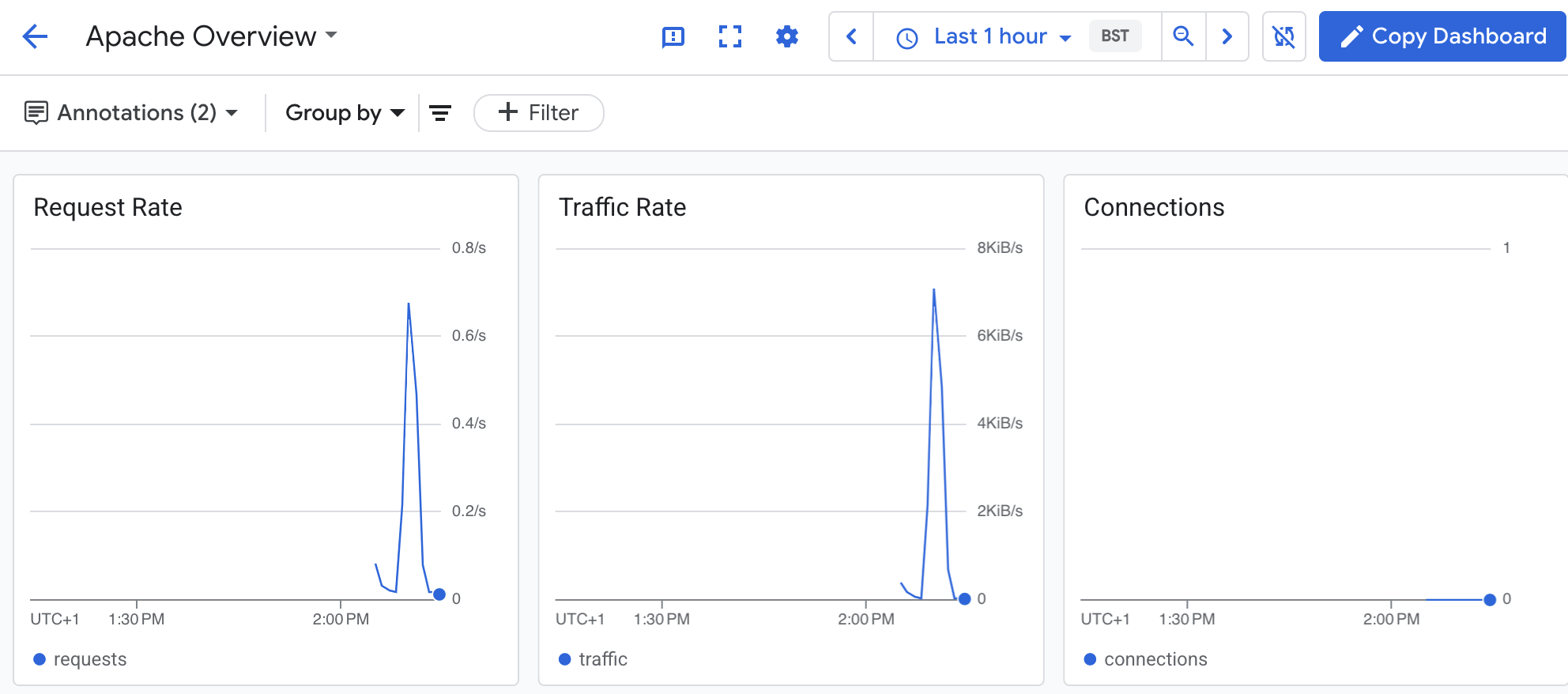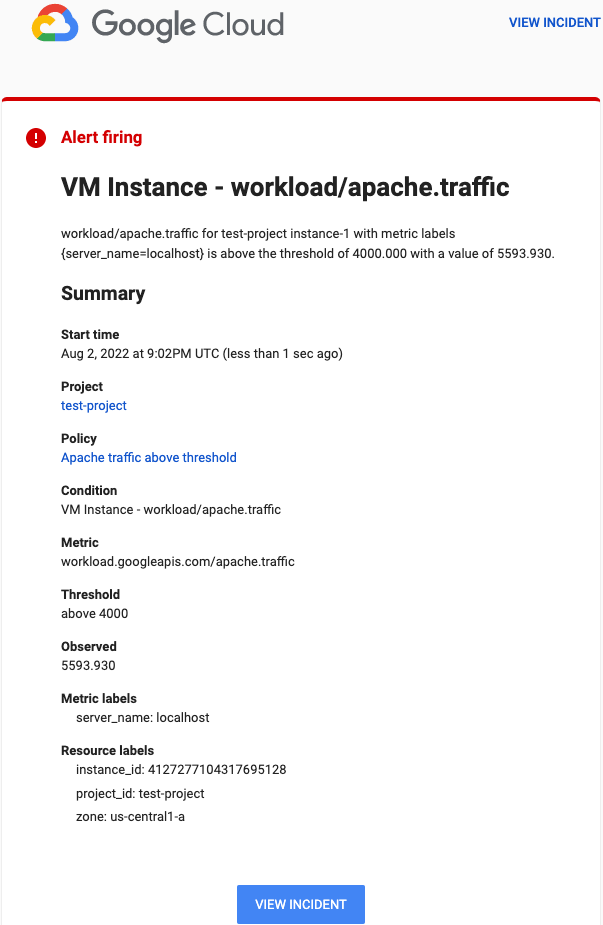Overview
In this lab you will create a compute engine to install and configure an Ops Agent. You will generate traffic and view metrics on the predefined Apache dashboard and also create an alerting policy.
Objectives
In this lab, you learn how to perform the following tasks:
- Create a Compute Engine VM instance.
- Install an Apache Web Server.
- Install and configure the Ops Agent for the Apache Web Server.
- Generate traffic and view metrics on the predefined Apache dashboard.
- Create an alerting policy.
Setup and requirements
For each lab, you get a new Google Cloud project and set of resources for a fixed time at no cost.
-
Click the Start Lab button. If you need to pay for the lab, a pop-up opens for you to select your payment method.
On the left is the Lab Details panel with the following:
- The Open Google Cloud console button
- Time remaining
- The temporary credentials that you must use for this lab
- Other information, if needed, to step through this lab
-
Click Open Google Cloud console (or right-click and select Open Link in Incognito Window if you are running the Chrome browser).
The lab spins up resources, and then opens another tab that shows the Sign in page.
Tip: Arrange the tabs in separate windows, side-by-side.
Note: If you see the Choose an account dialog, click Use Another Account.
-
If necessary, copy the Username below and paste it into the Sign in dialog.
{{{user_0.username | "Username"}}}
You can also find the Username in the Lab Details panel.
-
Click Next.
-
Copy the Password below and paste it into the Welcome dialog.
{{{user_0.password | "Password"}}}
You can also find the Password in the Lab Details panel.
-
Click Next.
Important: You must use the credentials the lab provides you. Do not use your Google Cloud account credentials.
Note: Using your own Google Cloud account for this lab may incur extra charges.
-
Click through the subsequent pages:
- Accept the terms and conditions.
- Do not add recovery options or two-factor authentication (because this is a temporary account).
- Do not sign up for free trials.
After a few moments, the Google Cloud console opens in this tab.
Note: To view a menu with a list of Google Cloud products and services, click the Navigation menu at the top-left, or type the service or product name in the Search field.

Task 1. Create a Compute Engine VM instance
In this task, you create a Compute Engine VM instance, and then configure its machine type, boot disk, and firewall rules to allow HTTP and HTTPS traffic,
-
In the Google Cloud console, in the Navigation menu ( ) click Compute Engine > VM instances.
) click Compute Engine > VM instances.
-
To create a VM instance, click Create instance.
Fill in the fields for your instance as follows:
-
Click Machine configuration, and then specify the following values:
| Field |
Value |
| Name |
quickstart-vm |
| Region |
|
| Zone |
|
| Series |
E2 |
| Machine Type |
e2-small |
-
Click OS and storage
-
Boot disk image: Debian GNU/Linux 12 (bookworm)
-
Click Networking
- In the Firewall field, select both Allow HTTP traffic and Allow HTTPS traffic.
Leave the rest of the fields at their default values.
- Click Create. When your VM is ready, it appears in the list of instances in the Instances tab.
Click Check my progress to verify the objective.
Create a Compute Engine VM instance
Task 2. Install an Apache Web Server
In this task, you deploy an Apache Web Server on your Compute Engine VM instance.
-
To open a terminal to your instance, in the Connect column, click SSH. If prompted, click Authorize.
-
To update the package lists on your instance, run the following command:
sudo apt-get update
- To install an Apache2 HTTP Server, run the following command:
sudo apt-get install apache2 php7.0
Note: If the previous command fails, then use sudo apt-get install apache2 php. If asked to continue the installation, enter Y.
- Open your browser and connect to your Apache2 HTTP server by using the URL
http://EXTERNAL_IP, where EXTERNAL_IP is the external IP address of your VM. You can find this address in the External IP column of your VM instance.
Note: If prompted, click Continue to site.

Click Check my progress to verify the objective.
Install an Apache Web Server
Task 3. Install and configure the Ops Agent
In this task, you install the Ops Agent on your VM instance and configure it to collect logs and metrics from the Apache Web Server.
To collect logs and metrics from your Apache Web Server, install the Ops Agent by using the terminal:
-
To open a terminal to your VM instance, in the Connect column, click SSH.
-
To install the Ops Agent, run the following command:
curl -sSO https://dl.google.com/cloudagents/add-google-cloud-ops-agent-repo.sh
sudo bash add-google-cloud-ops-agent-repo.sh --also-install
You see google-cloud-ops-agent installation succeeded.
- Copy the following command, then paste it into the terminal:
# Configures Ops Agent to collect telemetry from the app and restart Ops Agent.
set -e
# Create a back up of the existing file so existing configurations are not lost.
sudo cp /etc/google-cloud-ops-agent/config.yaml /etc/google-cloud-ops-agent/config.yaml.bak
# Configure the Ops Agent.
sudo tee /etc/google-cloud-ops-agent/config.yaml > /dev/null << EOF
metrics:
receivers:
apache:
type: apache
service:
pipelines:
apache:
receivers:
- apache
logging:
receivers:
apache_access:
type: apache_access
apache_error:
type: apache_error
service:
pipelines:
apache:
receivers:
- apache_access
- apache_error
EOF
sudo service google-cloud-ops-agent restart
sleep 60
The previous command creates the configuration to collect and ingest logs and metrics from the Apache Web Server. For more information about ingesting logs from the Apache Web Server, see Configure the Ops Agent for Apache Web Server.
Click Check my progress to verify the objective.
Install the Ops Agent
Task 4. Generate traffic and view metrics
In this task, you generate metrics on your Apache Web Server and view metric data on the automatically created Apache Overview dashboard.
To generate metrics on your Apache Web Server, do the following:
-
In the Google Cloud console, in the Navigation menu ( ) click Compute Engine > VM instances.
) click Compute Engine > VM instances.
-
In the Connect column, click SSH to open a terminal to your VM instance. If prompted, click Authorize.
-
To generate traffic on your Apache Web Server, run the following command:
timeout 120 bash -c -- 'while true; do curl localhost; sleep $((RANDOM % 4)) ; done'
The previous command generates traffic by making a request to the Apache Web Server every four seconds.
To view the Apache Overview dashboard, do the following:
-
In the Google Cloud console, in the Navigation menu ( ) click View all products > Observability > Monitoring.
) click View all products > Observability > Monitoring.
-
In the navigation pane, select Dashboards.
-
In All Dashboards, select the Apache Overview dashboard. The dashboard opens.
In the dashboard, there are several charts that contain information about your Apache and Compute Engine integration:

Click Check my progress to verify the objective.
Generate traffic and view metrics
Task 5. Create an alerting policy
In this task, you setup an email notification channel and then configure an alerting policy that monitors the traffic rate on your Apache Web Server, sending an email notification when the rate exceeds 4 KiB/s.
Setup email notification channel
-
In the Google Cloud console, in the Navigation menu ( ) click View all products > Observability > Monitoring.
) click View all products > Observability > Monitoring.
-
Click Alerting and then click Edit notification channels.
-
In the Email section, click Add new and enter your desired Email Address.
-
In Display Name, copy and paste your email address again.
-
Click Save.
Configure Alerting policy
-
In the Google Cloud console, in Observability, click Alerting and then click Create policy.
-
Select the time series to be monitored:
- Click Select a metric and enter VM instance into the filter bar.
- In the Active metric categories list, select Apache.
- In the Active metrics list, select workload/apache.traffic.
- Click Apply.
The chart for Apache traffic is shown.
-
In the Transform data section, select the following values and click Next:
-
Rolling window:
1 min
-
Rolling window function:
rate
-
In the Configure alert trigger section, select the following values and click Next:
-
Alert trigger:
Any time series violates
-
Threshold position:
Above threshold
-
Threshold value:
4000
-
In the Configure notifications and finalize alert section, select the following values:
-
Notification channels:
An email address you have access to
-
Incident autoclose duration:
30 min
-
Name the alert policy:
Apache traffic above threshold
-
Click Create policy. Your alerting policy is now active.
Click Check my progress to verify the objective.
Create an alerting policy
Task 6. Test the alerting policy
In this task, you test the alerting policy by generating traffic on your Apache Web Server. You the verify that an email notification is sent when the traffic rate exceeds the configured threshold.
-
In the Google Cloud console, in the Navigation menu ( ) click Compute Engine > VM instances.
) click Compute Engine > VM instances.
-
In the Connect column, click SSH to open a terminal to your VM instance. If prompted, click Authorize.
-
In the terminal, enter the following command:
timeout 120 bash -c -- 'while true; do curl localhost; sleep $((RANDOM % 4)) ; done'
The previous command generates traffic in your Apache Web Server.
After the traffic rate threshold value of 4 KiB/s is exceeded in your Apache Web Server, an email notification is sent. It might take several minutes for this process to complete.
The email notification you receive looks similar to the following:

Task 7. Review
In this lab, you learned how to install Ops Agent on a VM and use it to set an alerting policy to notify a recipient of potential issues with the instance.
End your lab
When you have completed your lab, click End Lab. Google Cloud Skills Boost removes the resources you’ve used and cleans the account for you.
You will be given an opportunity to rate the lab experience. Select the applicable number of stars, type a comment, and then click Submit.
The number of stars indicates the following:
- 1 star = Very dissatisfied
- 2 stars = Dissatisfied
- 3 stars = Neutral
- 4 stars = Satisfied
- 5 stars = Very satisfied
You can close the dialog box if you don't want to provide feedback.
For feedback, suggestions, or corrections, please use the Support tab.
Copyright 2025 Google LLC All rights reserved. Google and the Google logo are trademarks of Google LLC. All other company and product names may be trademarks of the respective companies with which they are associated.


 ) click Compute Engine > VM instances.
) click Compute Engine > VM instances.







